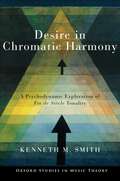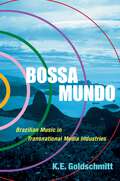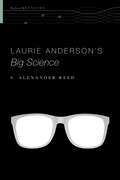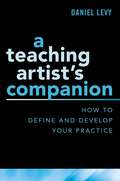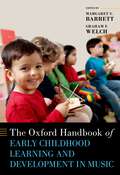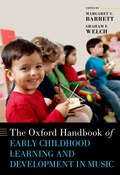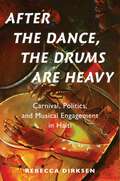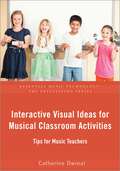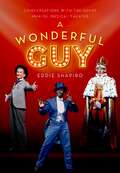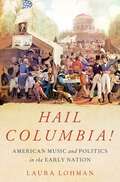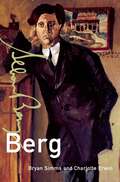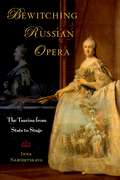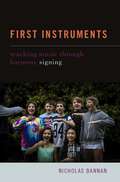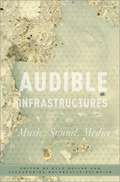- Table View
- List View
Desire in Chromatic Harmony: A Psychodynamic Exploration of Fin de Siècle Tonality (Oxford Studies in Music Theory)
by Kenneth M. SmithHow does musical harmony engage listeners in relations of desire? Where does this desire come from? Author Kenneth Smith seeks to answer these questions by analyzing works from the turn of the twentieth- century that are both harmonically enriched and psychologically complex. Desire in Chromatic Harmony yields a new theory of how chromatic chord progressions direct the listener on intricate journeys through harmonic space, mirroring the tensions of the psyche found in Schopenhauer, Freud, Lacan, Lyotard, and Deleuze. Smith extends this mode of enquiry into sophisticated music theory, while exploring philosophically engaged European and American composers such as Richard Strauss, Alexander Skryabin, Josef Suk, Charles Ives, and Aaron Copland. Focusing on harmony and chord progression, the book drills down into the diatonic undercurrent beneath densely chromatic and dissonant surfaces. From the obsession with death and mourning in Suk's asrael Symphony to an exploration of "perversion" in Strauss's elektra; from the Sufi mysticism of Szymanowski's Song of the Night to the failed fantasy of the American dream in Copland's The Tender Land, Desire in Chromatic Harmony cuts a path through the dense forests of chromatic complexity, revealing the psychological make-up of post-Wagnerian psychodynamic music.
Bossa Mundo: Brazilian Music in Transnational Media Industries (Currents in Latin American and Iberian Music)
by K.E. GoldschmittBrazilian music has been central to Brazil's national brand in the U.S. and U.K. since the early 1960s. From bossa nova in 1960s jazz and film, through the 1970s fusion and funk scenes, the world music boom of the late 1980s and the bossa nova remix revival at the turn of the millennium, and on to Brazilian musical distribution and branding in the streaming music era, Bossa Mundo: Brazilian Music in Transnational Media Industries focuses on watershed moments of musical breakthrough, exploring what the music may have represented in a particular historical moment alongside its deeper cultural impact. Through a discussion of the political meaning of mass-mediated music, author K. E. Goldschmitt argues for a shift in scholarly focus--from viewing music as simply a representation of Otherness to taking into account the broader media environment where listeners and intermediaries often have conflicting priorities. Goldschmitt demonstrates that the mediation of Brazilian music in an increasingly crowded transnational marketplace has lasting consequences for the creative output celebrated by Brazil. Like other culturally rich countries in Latin America--such as Cuba, Mexico, and Argentina--Brazil has captured the imagination of people in many parts of the world through its music, driving tourism and international financial investment, while increasing the country's prominence on the world stage Nevertheless, stereotypes of Brazilian music persist, especially those that valorize racial difference. Featuring interviews with key figures in the transnational circulation of Brazilian music, and in-depth discussions of well-known Brazilian musicians alongside artists who redefine what it means to be a Brazilian musician in the twenty-first century, Bossa Mundo shows the pernicious effects of branding racial diversity on musicians and audiences alike.
BOSSA MUNDO CILAM C: Brazilian Music in Transnational Media Industries (Currents in Latin American and Iberian Music)
by K.E. GoldschmittBrazilian music has been central to Brazil's national brand in the U.S. and U.K. since the early 1960s. From bossa nova in 1960s jazz and film, through the 1970s fusion and funk scenes, the world music boom of the late 1980s and the bossa nova remix revival at the turn of the millennium, and on to Brazilian musical distribution and branding in the streaming music era, Bossa Mundo: Brazilian Music in Transnational Media Industries focuses on watershed moments of musical breakthrough, exploring what the music may have represented in a particular historical moment alongside its deeper cultural impact. Through a discussion of the political meaning of mass-mediated music, author K. E. Goldschmitt argues for a shift in scholarly focus--from viewing music as simply a representation of Otherness to taking into account the broader media environment where listeners and intermediaries often have conflicting priorities. Goldschmitt demonstrates that the mediation of Brazilian music in an increasingly crowded transnational marketplace has lasting consequences for the creative output celebrated by Brazil. Like other culturally rich countries in Latin America--such as Cuba, Mexico, and Argentina--Brazil has captured the imagination of people in many parts of the world through its music, driving tourism and international financial investment, while increasing the country's prominence on the world stage Nevertheless, stereotypes of Brazilian music persist, especially those that valorize racial difference. Featuring interviews with key figures in the transnational circulation of Brazilian music, and in-depth discussions of well-known Brazilian musicians alongside artists who redefine what it means to be a Brazilian musician in the twenty-first century, Bossa Mundo shows the pernicious effects of branding racial diversity on musicians and audiences alike.
Laurie Anderson's Big Science (Oxford Keynotes)
by S. Alexander ReedShimmering in maximal minimalism, joyful bleakness, and bodiless intimacy, Laurie Anderson's Big Science diagnosed crises of meaning, scale, and identity in 1982. Decades later, the strange questions it poses loom even larger: How do we remain human when our identities are digitally distributed? Does technology bring us closer together or further apart? Can we experience the stillness of "now" when time is always moving? How does our experience become memory? Laurie Anderson pioneered new techniques and aesthetics in performance art, becoming its first and most enduring superstar. In this book, author S. Alexander Reed dives into the wonderfully strange making and meanings of this singular album and of its creator's long artistic career. Packed with scrupulous new research, reception history, careful description, and dizzying creativity, this book is an interdisciplinary love letter to a record whose sounds, politics, and expressions of gendered identity grow more relevant each day.
Laurie Anderson's Big Science (Oxford Keynotes)
by S. Alexander ReedShimmering in maximal minimalism, joyful bleakness, and bodiless intimacy, Laurie Anderson's Big Science diagnosed crises of meaning, scale, and identity in 1982. Decades later, the strange questions it poses loom even larger: How do we remain human when our identities are digitally distributed? Does technology bring us closer together or further apart? Can we experience the stillness of "now" when time is always moving? How does our experience become memory? Laurie Anderson pioneered new techniques and aesthetics in performance art, becoming its first and most enduring superstar. In this book, author S. Alexander Reed dives into the wonderfully strange making and meanings of this singular album and of its creator's long artistic career. Packed with scrupulous new research, reception history, careful description, and dizzying creativity, this book is an interdisciplinary love letter to a record whose sounds, politics, and expressions of gendered identity grow more relevant each day.
A Teaching Artist's Companion: How to Define and Develop Your Practice
by Daniel LevyYou are an artist, living the artist's life. But you also want to make a difference in the world as a teaching artist. You know how to pursue excellence in your art form; how can you pursue excellence in teaching artistry? A Teaching Artist's Companion: How to Define and Develop Your Practice is a how-to reference for veteran and beginning teaching artists alike. Artist-educator Daniel Levy has been working in classrooms, homeless shelters and correctional facilities for over thirty years. With humor and hard-won insight, Levy and a variety of contributing teaching artists narrate their successes and failures while focusing on the practical mechanics of working within conditions of limited time and resources. Levy organizes teaching artist practice within a framework of View, Design, and Respond. View is everything you value and believe about teaching and learning; Design is what you plan before you go into a classroom; Respond is how you react to and support your students face to face. With the aid of checklists, worksheets, and primary sources, A Teaching Artist's Companion invites you to define your own unique view, and guides your observing, critiquing, and shaping your practice over time.
TEACHING ARTIST'S COMPANION C: How to Define and Develop Your Practice
by Daniel LevyYou are an artist, living the artist's life. But you also want to make a difference in the world as a teaching artist. You know how to pursue excellence in your art form; how can you pursue excellence in teaching artistry? A Teaching Artist's Companion: How to Define and Develop Your Practice is a how-to reference for veteran and beginning teaching artists alike. Artist-educator Daniel Levy has been working in classrooms, homeless shelters and correctional facilities for over thirty years. With humor and hard-won insight, Levy and a variety of contributing teaching artists narrate their successes and failures while focusing on the practical mechanics of working within conditions of limited time and resources. Levy organizes teaching artist practice within a framework of View, Design, and Respond. View is everything you value and believe about teaching and learning; Design is what you plan before you go into a classroom; Respond is how you react to and support your students face to face. With the aid of checklists, worksheets, and primary sources, A Teaching Artist's Companion invites you to define your own unique view, and guides your observing, critiquing, and shaping your practice over time.
The Oxford Handbook of Early Childhood Learning and Development in Music (Oxford Handbooks)
Investigation of the role of music in early life and learning has been somewhat fragmented, with studies being undertaken within a range of fields with little apparent conversation across disciplinary boundaries, and with an emphasis on pre-schoolers' and school-aged childrens' learning and engagement. The Oxford Handbook of Early Childhood Learning and Development in Music brings together leading researchers in infant and early childhood cognition, music education, music therapy, neuroscience, cultural and developmental psychology, and music sociology to interrogate questions of how our capacity for music develops from birth, and its contributions to learning and development. Researchers in cultural psychology and sociology of musical childhoods investigate those factors that shape children's musical learning and development and the places and spaces in which children encounter and engage with music. These issues are complemented with consideration of the policy environment at local, national and global levels in relation to music early learning and development and the ways in which these shape young children's music experiences and opportunities. The volume also explores issues of music provision and developmental contributions for children with Special Education Needs, children living in medical settings and participating in music therapy, and those living in sites of trauma and conflict. Consideration of these environments provides a context to examine music learning and development in family, community and school settings including general and specialized school environments. Authors trace the trajectories of development within and across cultures and settings and in that process identify those factors that facilitate or constrain children's early music learning and development.
The Oxford Handbook of Early Childhood Learning and Development in Music (Oxford Handbooks)
by Margaret S. Barrett and Graham F. WelchInvestigation of the role of music in early life and learning has been somewhat fragmented, with studies being undertaken within a range of fields with little apparent conversation across disciplinary boundaries, and with an emphasis on pre-schoolers' and school-aged childrens' learning and engagement. The Oxford Handbook of Early Childhood Learning and Development in Music brings together leading researchers in infant and early childhood cognition, music education, music therapy, neuroscience, cultural and developmental psychology, and music sociology to interrogate questions of how our capacity for music develops from birth, and its contributions to learning and development. Researchers in cultural psychology and sociology of musical childhoods investigate those factors that shape children's musical learning and development and the places and spaces in which children encounter and engage with music. These issues are complemented with consideration of the policy environment at local, national and global levels in relation to music early learning and development and the ways in which these shape young children's music experiences and opportunities. The volume also explores issues of music provision and developmental contributions for children with Special Education Needs, children living in medical settings and participating in music therapy, and those living in sites of trauma and conflict. Consideration of these environments provides a context to examine music learning and development in family, community and school settings including general and specialized school environments. Authors trace the trajectories of development within and across cultures and settings and in that process identify those factors that facilitate or constrain children's early music learning and development.
After the Dance, the Drums Are Heavy: Carnival, Politics, and Musical Engagement in Haiti (Currents in Latin American and Iberian Music)
by Rebecca DirksenRichly ethnographic and a compelling read, After the Dance, the Drums Are Heavy is a study of carnival, politics, and the musical engagement of ordinary citizens and celebrity musicians in contemporary Haiti. The book explores how the self-declared president of konpa Sweet Micky (Michel Martelly) rose to the nation's highest office while methodically crafting a political product inherently entangled with his musical product. It offers deep historical perspective on the characteristics of carnivalesque verbal play-and the performative skillset of the artist (Sweet Micky) who dominated carnival for more than a decade-including vulgarities and polemics. Yet there has been profound resistance to this brand of politics led by many other high-profile artists, including Matyas and Jòj, Brothers Posse, Boukman Eksperyans, and RAM. These groups have each released popular carnival songs that have contributed to the public's discussions on what civic participation and citizenship in Haiti can and should be. Drawing on more than a decade and a half of ethnographic research, Rebecca Dirksen presents an in-depth consideration of politically and socially engaged music and what these expressions mean for the Haitian population in the face of challenging political and economic circumstances. After the Dance, the Drums Are Heavy centers the voices of Haitian musicians and regular citizens by extensively sharing interviews and detailed analyses of musical performance in the context of contemporary events well beyond the musical realm.
AFTER THE DANCE,DRUM IS HEAVY CILAM C: Carnival, Politics, and Musical Engagement in Haiti (Currents in Latin American and Iberian Music)
by Rebecca DirksenRichly ethnographic and a compelling read, After the Dance, the Drums Are Heavy is a study of carnival, politics, and the musical engagement of ordinary citizens and celebrity musicians in contemporary Haiti. The book explores how the self-declared president of konpa Sweet Micky (Michel Martelly) rose to the nation's highest office while methodically crafting a political product inherently entangled with his musical product. It offers deep historical perspective on the characteristics of carnivalesque verbal play-and the performative skillset of the artist (Sweet Micky) who dominated carnival for more than a decade-including vulgarities and polemics. Yet there has been profound resistance to this brand of politics led by many other high-profile artists, including Matyas and Jòj, Brothers Posse, Boukman Eksperyans, and RAM. These groups have each released popular carnival songs that have contributed to the public's discussions on what civic participation and citizenship in Haiti can and should be. Drawing on more than a decade and a half of ethnographic research, Rebecca Dirksen presents an in-depth consideration of politically and socially engaged music and what these expressions mean for the Haitian population in the face of challenging political and economic circumstances. After the Dance, the Drums Are Heavy centers the voices of Haitian musicians and regular citizens by extensively sharing interviews and detailed analyses of musical performance in the context of contemporary events well beyond the musical realm.
Interactive Visual Ideas for Musical Classroom Activities: Tips for Music Teachers (Essential Music Technology:The Prestissimo Series)
by Catherine DwinalThe digital interactive projection system is a staple of nearly every music classroom in the United States. By allowing teachers to show students methods and outcomes from a computer, these systems have become a necessity for reaching students who grew up as digital natives. But, as author and distinguished music educator Catie Dwinal demonstrates, such systems can be much more meaningful pedagogical tools than simple replacements for chalk boards. In this book she offers practical tips, tricks, resources, and 50 activities ideal to use alongside classroom projection systems. She focuses especially on tips and activities for beginning teachers, giving them the confidence to take a step out of their comfort zone and learn new ways of engaging students with technology. More than this, she provides reference materials that will serve as a trusted reference resource for years to come.
Interactive Visual Ideas for Musical Classroom Activities: Tips for Music Teachers (Essential Music Technology:The Prestissimo Series)
by Catherine DwinalThe digital interactive projection system is a staple of nearly every music classroom in the United States. By allowing teachers to show students methods and outcomes from a computer, these systems have become a necessity for reaching students who grew up as digital natives. But, as author and distinguished music educator Catie Dwinal demonstrates, such systems can be much more meaningful pedagogical tools than simple replacements for chalk boards. In this book she offers practical tips, tricks, resources, and 50 activities ideal to use alongside classroom projection systems. She focuses especially on tips and activities for beginning teachers, giving them the confidence to take a step out of their comfort zone and learn new ways of engaging students with technology. More than this, she provides reference materials that will serve as a trusted reference resource for years to come.
A Wonderful Guy: Conversations with the Great Men of Musical Theater
Fascinating, never-before-published interviews with Broadway's leading men offer behind-the-scenes looks at the careers of some of the most beloved perfomers today. In A Wonderful Guy, a follow up to Nothing Like a Dame: Conversations with the Great Women of Musical Theater, theatre journalist Eddie Shapiro sits down for intimate, career-encompassing conversations with nineteen of Broadway's most prolific and fascinating leading men. Full of detailed stories and reflections, his conversations with such luminaries as Joel Grey, Ben Vereen, Norm Lewis, Gavin Creel, Cheyenne Jackson, Jonathan Groff and a host of others dig deep into each actor's career; together, these chapters tell the story of what it means to be a leading man on Broadway over the past fifty years. Alan Cumming described Nothing Like a Dame, as "an encyclopedia of modern musical theatre via a series of tender meetings between a diehard fan and his idols. Because of Eddie Shapiro's utter guilelessness, these women open up and reveal more than they ever have before, and we get to be the third guest at each encounter." A Wonderful Guy brings more fly-on-the-wall opportunities for fans to savour, students to study, and even the unindoctrinated to understand the life of the performing artist.
A Wonderful Guy: Conversations with the Great Men of Musical Theater
by Eddie ShapiroFascinating, never-before-published interviews with Broadway's leading men offer behind-the-scenes looks at the careers of some of the most beloved perfomers today. In A Wonderful Guy, a follow up to Nothing Like a Dame: Conversations with the Great Women of Musical Theater, theatre journalist Eddie Shapiro sits down for intimate, career-encompassing conversations with nineteen of Broadway's most prolific and fascinating leading men. Full of detailed stories and reflections, his conversations with such luminaries as Joel Grey, Ben Vereen, Norm Lewis, Gavin Creel, Cheyenne Jackson, Jonathan Groff and a host of others dig deep into each actor's career; together, these chapters tell the story of what it means to be a leading man on Broadway over the past fifty years. Alan Cumming described Nothing Like a Dame, as "an encyclopedia of modern musical theatre via a series of tender meetings between a diehard fan and his idols. Because of Eddie Shapiro's utter guilelessness, these women open up and reveal more than they ever have before, and we get to be the third guest at each encounter." A Wonderful Guy brings more fly-on-the-wall opportunities for fans to savour, students to study, and even the unindoctrinated to understand the life of the performing artist.
Hail Columbia!: American Music and Politics in the Early Nation
by Laura LohmanTo the tune of "Yankee Doodle," the American obsession with politics was born alongside America itself. From the end of the Revolutionary War through to the antebellum era, music made front page news and brought men to blows. Both common citizens and politiciansâeven early presidents of the young nationâused well-known songs to fuel heated debates over the meaning of liberty, the future and nature of the republic, and Americans' proper place within it. As both propaganda and protest, music called for allegiance to a new federal government, spread utopian visions of worldwide revolution, broadcast infringements on American freedoms, and spun exaggerated tales of national military might. In Hail Columbia!, author Laura Lohman uncovers hundreds of songs circulated in newspapers, broadsides, song collections, sheet music, manuscripts, and scrapbooks over the late eighteenth and early nineteenth century. These give evidence that a diversity of Americansâelite lawyers, immigrant actresses, humble craftsmen, and African American abolitionistsâemployed music for political purposes, creating new and deeply partisan lyrics to famous tunes of "Yankee Doodle," "The Star-Spangled Banner," and the like. These charged versions found their way to electioneering, tavern gatherings, presidential encomia, street theatre, and community celebrations, making song a political weapon between neighbours and citizens, to hail the new nation in partisan terms.
Hail Columbia!: American Music and Politics in the Early Nation
by Laura LohmanTo the tune of "Yankee Doodle," the American obsession with politics was born alongside America itself. From the end of the Revolutionary War through to the antebellum era, music made front page news and brought men to blows. Both common citizens and politiciansâeven early presidents of the young nationâused well-known songs to fuel heated debates over the meaning of liberty, the future and nature of the republic, and Americans' proper place within it. As both propaganda and protest, music called for allegiance to a new federal government, spread utopian visions of worldwide revolution, broadcast infringements on American freedoms, and spun exaggerated tales of national military might. In Hail Columbia!, author Laura Lohman uncovers hundreds of songs circulated in newspapers, broadsides, song collections, sheet music, manuscripts, and scrapbooks over the late eighteenth and early nineteenth century. These give evidence that a diversity of Americansâelite lawyers, immigrant actresses, humble craftsmen, and African American abolitionistsâemployed music for political purposes, creating new and deeply partisan lyrics to famous tunes of "Yankee Doodle," "The Star-Spangled Banner," and the like. These charged versions found their way to electioneering, tavern gatherings, presidential encomia, street theatre, and community celebrations, making song a political weapon between neighbours and citizens, to hail the new nation in partisan terms.
Berg (Master Musicians Series)
by Bryan R. Simms Charlotte ErwinAlban Berg (1885-1935), a student of Arnold Schoenberg and one of the most prominent composers of the Second Viennese School, is counted among the pioneers of twelve-tone serialism. His circle included not only the musicians of the Wiener modern but also prominent literary and artistic figures from Vienna's brilliant fin-de-siècle. In his short lifetime he composed two ground-breaking operas, Wozzeck and Lulu, as well as chamber works, songs, and symphonic compositions. His final completed work, the deeply moving and elegiac Violin Concerto, is performed by leading soloists across the world. This new life-and-works study from authors Bryan R. Simms and Charlotte Erwin delivers a fresh perspective formed from comprehensive study of primary sources that reveal the forces that shaped Berg's personality, career, and artistic outlook. One such force was Berg's wife, Helene Nahowski Berg, and the book provides a unique assessment of her role in the composer's life and work, as well as her later quest to shape his artistic legacy in the forty-one years of her widowhood. The authors present insightful analysis of all of Berg's major works, bringing into play Berg's own analyses of the music, many of which have not been considered in existing scholarship. Berg is an accessible and all-encompassing resource for all readers who wish to learn about the life and music of this composer, one of the great figures in modern music.
Berg (Master Musicians Series)
by Bryan R. Simms Charlotte ErwinAlban Berg (1885-1935), a student of Arnold Schoenberg and one of the most prominent composers of the Second Viennese School, is counted among the pioneers of twelve-tone serialism. His circle included not only the musicians of the Wiener modern but also prominent literary and artistic figures from Vienna's brilliant fin-de-siècle. In his short lifetime he composed two ground-breaking operas, Wozzeck and Lulu, as well as chamber works, songs, and symphonic compositions. His final completed work, the deeply moving and elegiac Violin Concerto, is performed by leading soloists across the world. This new life-and-works study from authors Bryan R. Simms and Charlotte Erwin delivers a fresh perspective formed from comprehensive study of primary sources that reveal the forces that shaped Berg's personality, career, and artistic outlook. One such force was Berg's wife, Helene Nahowski Berg, and the book provides a unique assessment of her role in the composer's life and work, as well as her later quest to shape his artistic legacy in the forty-one years of her widowhood. The authors present insightful analysis of all of Berg's major works, bringing into play Berg's own analyses of the music, many of which have not been considered in existing scholarship. Berg is an accessible and all-encompassing resource for all readers who wish to learn about the life and music of this composer, one of the great figures in modern music.
Bewitching Russian Opera: The Tsarina from State to Stage
by Inna NaroditskayaIn Bewitching Russian Opera: The Tsarina from State to Stage, author Inna Naroditskaya investigates the musical lives of four female monarchs who ruled Russia for most of the eighteenth century: Catherine I, Anna, Elizabeth, and Catherine the Great. Engaging with ethnomusicological, historical, and philological approaches, her study traces the tsarinas' deeply invested interest in musical drama, as each built theaters, established drama schools, commissioned operas and ballets, and themselves wrote and produced musical plays. Naroditskaya examines the creative output of the tsarinas across the contexts in which they worked and lived, revealing significant connections between their personal creative aspirations and contemporary musical-theatrical practices, and the political and state affairs conducted during their reigns. Through contemporary performance theory, she demonstrates how the opportunity for role-playing and costume-changing in performative spaces allowed individuals to cross otherwise rigid boundaries of class and gender. A close look at a series of operas and musical theater productions--from Catherine the Great's fairy tale operas to Tchaikovsky's Pique Dame--illuminates the transition of these royal women from powerful political and cultural figures during their own reigns, to a marginalized and unreal Other under the patriarchal dominance of the subsequent period. These tsarinas successfully fostered the concept of a modern nation and collective national identity, only to then have their power and influence undone in Russian cultural consciousness through the fairy-tales operas of the 19th century that positioned tsarinas as "magical" and dangerous figures rightfully displaced and conquered--by triumphant heroes on the stage, and by the new patriarchal rulers in the state. Ultimately, this book demonstrates that the theater served as an experimental space for these imperial women, in which they rehearsed, probed, and formulated gender and class roles, and performed on the musical stage political ambitions and international conquests which they would later enact on the world stage itself.
BEWITCHING RUSSIAN OPERA C: The Tsarina from State to Stage
by Inna NaroditskayaIn Bewitching Russian Opera: The Tsarina from State to Stage, author Inna Naroditskaya investigates the musical lives of four female monarchs who ruled Russia for most of the eighteenth century: Catherine I, Anna, Elizabeth, and Catherine the Great. Engaging with ethnomusicological, historical, and philological approaches, her study traces the tsarinas' deeply invested interest in musical drama, as each built theaters, established drama schools, commissioned operas and ballets, and themselves wrote and produced musical plays. Naroditskaya examines the creative output of the tsarinas across the contexts in which they worked and lived, revealing significant connections between their personal creative aspirations and contemporary musical-theatrical practices, and the political and state affairs conducted during their reigns. Through contemporary performance theory, she demonstrates how the opportunity for role-playing and costume-changing in performative spaces allowed individuals to cross otherwise rigid boundaries of class and gender. A close look at a series of operas and musical theater productions--from Catherine the Great's fairy tale operas to Tchaikovsky's Pique Dame--illuminates the transition of these royal women from powerful political and cultural figures during their own reigns, to a marginalized and unreal Other under the patriarchal dominance of the subsequent period. These tsarinas successfully fostered the concept of a modern nation and collective national identity, only to then have their power and influence undone in Russian cultural consciousness through the fairy-tales operas of the 19th century that positioned tsarinas as "magical" and dangerous figures rightfully displaced and conquered--by triumphant heroes on the stage, and by the new patriarchal rulers in the state. Ultimately, this book demonstrates that the theater served as an experimental space for these imperial women, in which they rehearsed, probed, and formulated gender and class roles, and performed on the musical stage political ambitions and international conquests which they would later enact on the world stage itself.
First Instruments: Teaching Music Through Harmony Signing
by Nicholas BannanWritten for music educators from K - 5 onwards, First Instruments is a practical guide to teaching musical ideas through the first instruments we develop in early childhood, laying the foundation for how the collective creativity the book presents can sustain a lifelong commitment to music-making: voice and hand gestures. Founded on the belief that all children are musical, the book gives music teachers the necessary tools to develop students' confident understanding of pitch relationships through improvisation and composition. Author Nicholas Bannan, a veteran pedagogue and children's choir director, accomplishes this in a classroom-tested system that combines Kodály hand signs with extended use of physical motions that together result in deeply embodied musical knowledge. By participating in the book's many group exercises, students develop this knowledge that ultimately paves the way for acquisition and functional working knowledge of harmony that tends to elude most theory students. As Bannan shows, all effective music teaching needs to involve singing as the portal to a secure and transferable response to pitch. First Instruments encourages educators to draw on games, tasks, and activities in relation to their own curriculum planning. Marrying the development of fluent singing abilities with harmonic understandings, this approach supports musical creativity that is not dominated by the conventional features of a particular genre or style, but instead liberates the musical imagination and enables the exploration of musical styles from throughout history and all over the world.
FIRST INSTRUMENTS C: Teaching Music Through Harmony Signing
by Nicholas BannanWritten for music educators from K - 5 onwards, First Instruments is a practical guide to teaching musical ideas through the first instruments we develop in early childhood, laying the foundation for how the collective creativity the book presents can sustain a lifelong commitment to music-making: voice and hand gestures. Founded on the belief that all children are musical, the book gives music teachers the necessary tools to develop students' confident understanding of pitch relationships through improvisation and composition. Author Nicholas Bannan, a veteran pedagogue and children's choir director, accomplishes this in a classroom-tested system that combines Kodály hand signs with extended use of physical motions that together result in deeply embodied musical knowledge. By participating in the book's many group exercises, students develop this knowledge that ultimately paves the way for acquisition and functional working knowledge of harmony that tends to elude most theory students. As Bannan shows, all effective music teaching needs to involve singing as the portal to a secure and transferable response to pitch. First Instruments encourages educators to draw on games, tasks, and activities in relation to their own curriculum planning. Marrying the development of fluent singing abilities with harmonic understandings, this approach supports musical creativity that is not dominated by the conventional features of a particular genre or style, but instead liberates the musical imagination and enables the exploration of musical styles from throughout history and all over the world.
Audible Infrastructures (Critical Conjunctures in Music and Sound)
Our day-to-day musical enjoyment seems so simple, so easy, so automatic. Songs instantly emanate from our computers and phones, at any time of day. The tools for playing and making music, such as records and guitars, wait for us in stores, ready for purchase and use. And when we no longer need them, we can leave them at the curb, where they disappear effortlessly and without a trace. These casual engagements often conceal the complex infrastructures that make our musical cultures possible. Audible Infrastructures takes readers to the sawmills, mineshafts, power grids, telecoms networks, transport systems, and junk piles that seem peripheral to musical culture and shows that they are actually pivotal to what music is, how it works, and why it matters. Organized into three parts dedicated to the main phases in the social life and death of musical commodities resources and production, circulation and transmission, failure and waste this book provides a concerted archaeology of music's media infrastructures. As contributors reveal the material-environmental realities and political-economic conditions of music and listening, they open our eyes to the hidden dimensions of how music is made, delivered, and disposed of. In rethinking our responsibilities as musicians and listeners, this book calls for nothing less than a reconsideration of how music comes to sound.
Audible Infrastructures (Critical Conjunctures in Music and Sound)
by Kyle Devine and Alexandrine Boudreault-FournierOur day-to-day musical enjoyment seems so simple, so easy, so automatic. Songs instantly emanate from our computers and phones, at any time of day. The tools for playing and making music, such as records and guitars, wait for us in stores, ready for purchase and use. And when we no longer need them, we can leave them at the curb, where they disappear effortlessly and without a trace. These casual engagements often conceal the complex infrastructures that make our musical cultures possible. Audible Infrastructures takes readers to the sawmills, mineshafts, power grids, telecoms networks, transport systems, and junk piles that seem peripheral to musical culture and shows that they are actually pivotal to what music is, how it works, and why it matters. Organized into three parts dedicated to the main phases in the social life and death of musical commodities resources and production, circulation and transmission, failure and waste this book provides a concerted archaeology of music's media infrastructures. As contributors reveal the material-environmental realities and political-economic conditions of music and listening, they open our eyes to the hidden dimensions of how music is made, delivered, and disposed of. In rethinking our responsibilities as musicians and listeners, this book calls for nothing less than a reconsideration of how music comes to sound.
